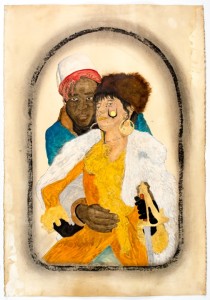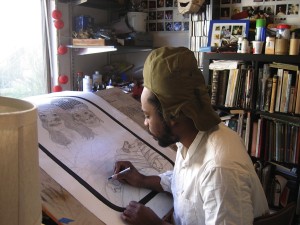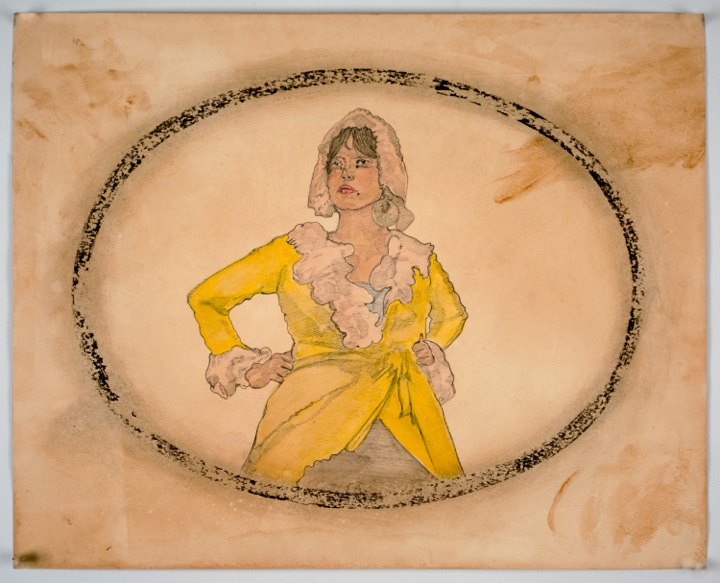
Cokkie Snoei Gallery Rotterdam shows Frohawk Two Feathers on ‘Amsterdam Drawing’, NDSM-werf, Amsterdam North.
From September 18 till September 21
Clovis and Beertje, 2014.
About:
Frohawk Two Feathers is an artist, historian, myth-maker and codifier. As his unusual moniker suggests, Frohawk is not your average storyteller. His illustrated tales look like the unexpected menage-a-trois of your history textbook, a romantic-era portrait, and your fav old school hip hop album art. It doesn’t quite make sense and yet, it works.
“All Gold Everything. An Elegy” finishes Frohawk’s three-part exhibition detailing the complex conquest of Hispanola, remixed. In case you were wondering, the title was snagged from a Soulja Boy hit from 2011 that goes something like: “All gold. All gold anything. All gold. All gold everything.”

Led by our flawed hero Andre Lafayette, we enter an alternate reality of 18th century Haiti, where face tattoos tell tales and colonists show off their bounty like the baddest bling. With titles like “Let Me Upgrade Ya” and “He Dead,” Frohawk imbues his hyper-complex narrative with enough humor and swagger to keep it as light as his delicate pen strokes.
We asked Frohawk to tell us more about the Haitian history that never quite happened. Scroll down for a slideshow.
HP: Can you give a quick run-down of the narrative of “All Gold Everything” and tell us a little about the main character Andre?
FTF: Originally I started this whole [three-part] series in Los Angeles last February. First it is a retelling, my fictional retelling, of the conquest of Haiti by the slaves, from the Frenglish, in my history. And then there is also a war between the darker skin slaves and the lighter skin slaves. The second part of the narrative is when Andre, our main character, finally kicks the higher class people of color out of the island. He takes over one half of the island of Hispanola. In ‘All Gold Everything,’ the third and final part, we have Andre taking over the whole island of Hispanola, which includes both Haiti and the Dominican Republic, becoming his greatest achievement. Meanwhile he is also funding a revolution in Jamaica, Puerto Rico, Columbia, and giving away all this money. Which is kind of what Haiti did, even though much later than it happened in my version.
The main character is Andre Lafayette — Andre I of Hispanola is his reign name. Andre, in his consolidation of power, made a lot of enemies because he basically reinstated a slave-like economic system. His main trusted generals wait for him to consolidate his rule over the entire island and then they assassinate him. You can look at Andre in two different ways. You can look at him as this great hero, but he is also this human being. He cheats on his wife, he drinks… I want to bring a very “average Joe” quality to these great leaders.
 Map of Europe 1794, 2012.
Map of Europe 1794, 2012.
HP: How did you go about researching this?
FTF: Basically it’s the history of Haiti in about four years. I am pretty much taking from 1790 to 1794. As a child I was always a huge fan of Toussaint L’Ouverture andJean Jacques Dessalines, who is the guy who I basically modelled Andre off of. He consolidated his rule over Haiti, he kicked out the French, and then he was assassinated. So we get a very fast and altered version of the life of Jean Jacques Dessalines. I also like to inject a lot of humor into my work because I am dealing with a heavy subject, you know like race and power and colonization.
HP: Your exhibition’s title comes from a Soulja Boy song. What connections are you making between hip hop and imperialism, and how does performing masculinity play a role?
FTF: Hip hop, especially in its infancy, was always connected with royalty. With being supreme, with the gold chains, there was a gaudiness to it, a flashiness. That’s my era, I grew up when hip hop started, the golden age of hip hop, so I tend to reference it a lot in my work. So all gold everything — that’s like the highest you can get. Well, I guess technically that would be all platinum everything… But basically it’s like, Bam! I made it.
About the masculinity: A lot of the poses I do come from classic B-boy stances or B-girl stances. Looking at that through the lens of old classical portraiture, these very stately powerful poses, I am trying to draw that link between hip hop preoccupation with royalty with the works of Delacroix and Géricault in the romantic era. But then again, I do sometimes try to make the men look more feminine and the women look more masculine to play with the subtle relationship of power.
 Mulattress of the Veld, 2012.
Mulattress of the Veld, 2012.
HP: A lot of your characters have tattoos. How do tattoos play into your motif of storytelling and also, do you have any?
FTF: I don’t, but it’s funny you should ask. I have this birthmark in the middle of my forehead which is like nature’s tattoo — it looks like an extended widow’s peak. Everyone has always always been like “What happened?” “Black Gorbachev!” But how [tattoos] originally came into play was when I was starting out I was using a lot of text to push what I wanted to say. And when I started getting into portraits more I was like, Wow, I can tell this whole story and relate it to street culture or gang culture and tell the story through the tattoos. First I codified the system and created the myth of how these tattoos came to be, how we got this culture of tattoos. This is kind of a commentary on present day where you see a lot of people with tattoos where 40 years ago it would have been frowned upon. In this case the military is influencing the people, where today it is pop culture that influences us.
 Portrait of a Mulattress Drying Her Hair, 2011.
Portrait of a Mulattress Drying Her Hair, 2011.
Copyright: Huffington Post, 09-12-2012.
